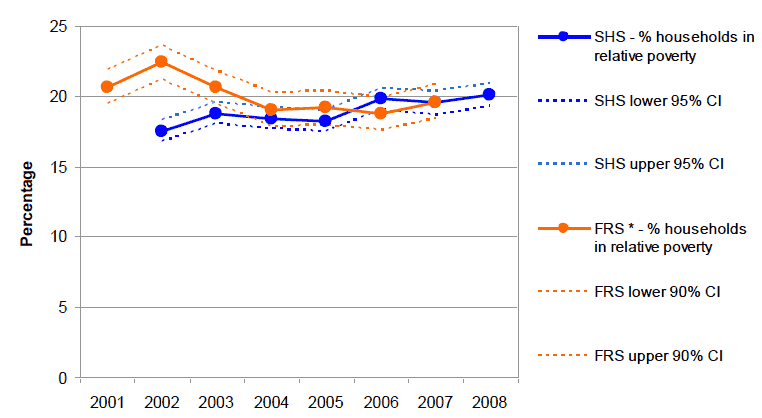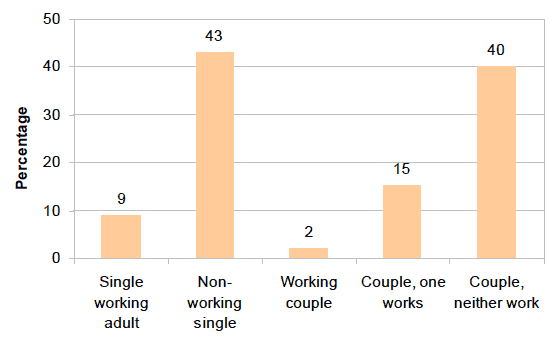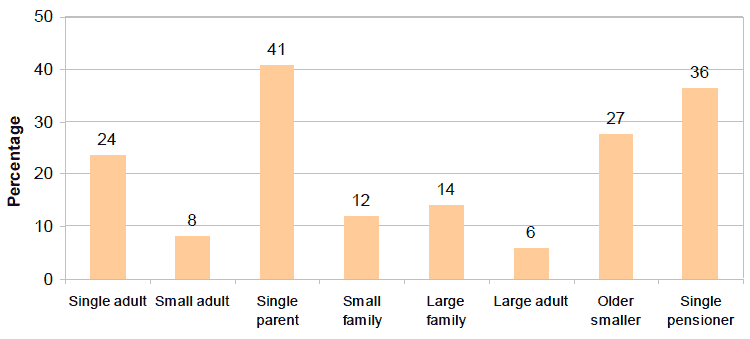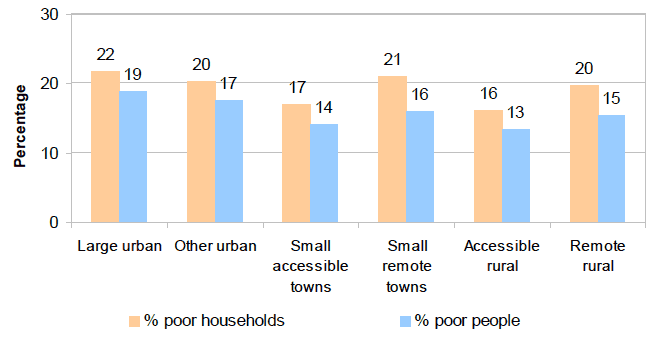Relative poverty across Scottish Local Authorities
A report which presents new figures about the proportion of households in relative poverty at LA level across Scotland.
National figures
From the Scottish Household Survey estimates were produced for the proportion of households in relative poverty between 2002 and 2008. The following chart presents these estimates and compares them to estimates from the Family Resources Survey.
- Between 2004 and 2008 between 18 and 20 percent of Scottish households were in relative poverty.
- For most years the two surveys produce estimates which are close to one another and for every year after 2002 the 95% confidence intervals for the two estimates were overlapping. This indicates that the estimates from the two surveys are not statistically different form one another.
- In 2002 there was a 5 percentage point difference between the estimates from the two surveys. Scottish Government analysts have not looked into this difference in great detail however, one potential reason for this difference is that the process used to produce these figures does not work as well for early years as the models involved were "fitted" on 2007 data.
Figure 1 - Relative poverty in Scotland: Estimates from the SHS and FRS 2001 to 2008

* Family Resources Survey figures are for financial not calendar years i.e. 2006 = 2006/07
Table 1 compares the most recent figures which are available from the two surveys. Those from the 2008 SHS and the 2007/08 FRS. They show good consistency between the two sources.
Table 1- Percentage of households, people and children in relative poverty: FRS 2007/08 and SHS 2008
Households in relative poverty |
People in relative poverty |
Children in relative poverty |
||||
|---|---|---|---|---|---|---|
% |
000s |
% |
000s |
% |
000s |
|
SHS 2008 |
20 |
450 |
17 |
860 |
20 |
180 |
FRS 2007/08 |
20 |
450 |
17 |
860 |
20 |
200 |
The following chart examines the proportion of different family types that are in relative poverty according to the SHS. In line with other sources such as the Family Resources Survey this shows that the prevalence of relative poverty is much higher among families where no-one is working. Forty percent of families headed by a couple where no-one is working are in relative poverty compared with only two percent of those families headed by a couple where both adults work.
Figure 2 - Relative poverty by number of workers in household head couple: Scotland 2008

Source: Scottish Household Survey 2008
Figure 3 shows the percentage of households of different family types which are in relative poverty. Pensioner households and those headed by a single adult, both with and without dependent children, are at the greatest risk of relative poverty.
Figure 3 - Percentage of households of different family types in relative poverty: Scotland 2008

Source: Scottish Household Survey 2008
Figure 4 displays one example of the type of analysis which, until now, has not previously been possible for Scotland. It presents the proportion of households in relative poverty in urban and rural areas. A robust breakdown of this level of detail has not been possible using the Family Resources Survey because of small sample sizes in rural areas. Taking advantage of the larger sample size in the SHS however it is possible.
The chart shows that the percentage of households in relative poverty in urban and remote rural areas is around 20 to 22 percent. This is higher than in accessible rural areas. This pattern is not the same however, when looking at the percentage of people, rather than households, in poverty. The percentage of people in relative poverty is higher in urban areas than rural areas, regardless of accessibility. This might suggest that many of those households in relative poverty in remote rural households are made up of smaller numbers of people than those in urban areas.
Figure 4 - Percentage of households and people in different geographical areas which are in relative poverty: Scotland 2008

There is a problem
Thanks for your feedback